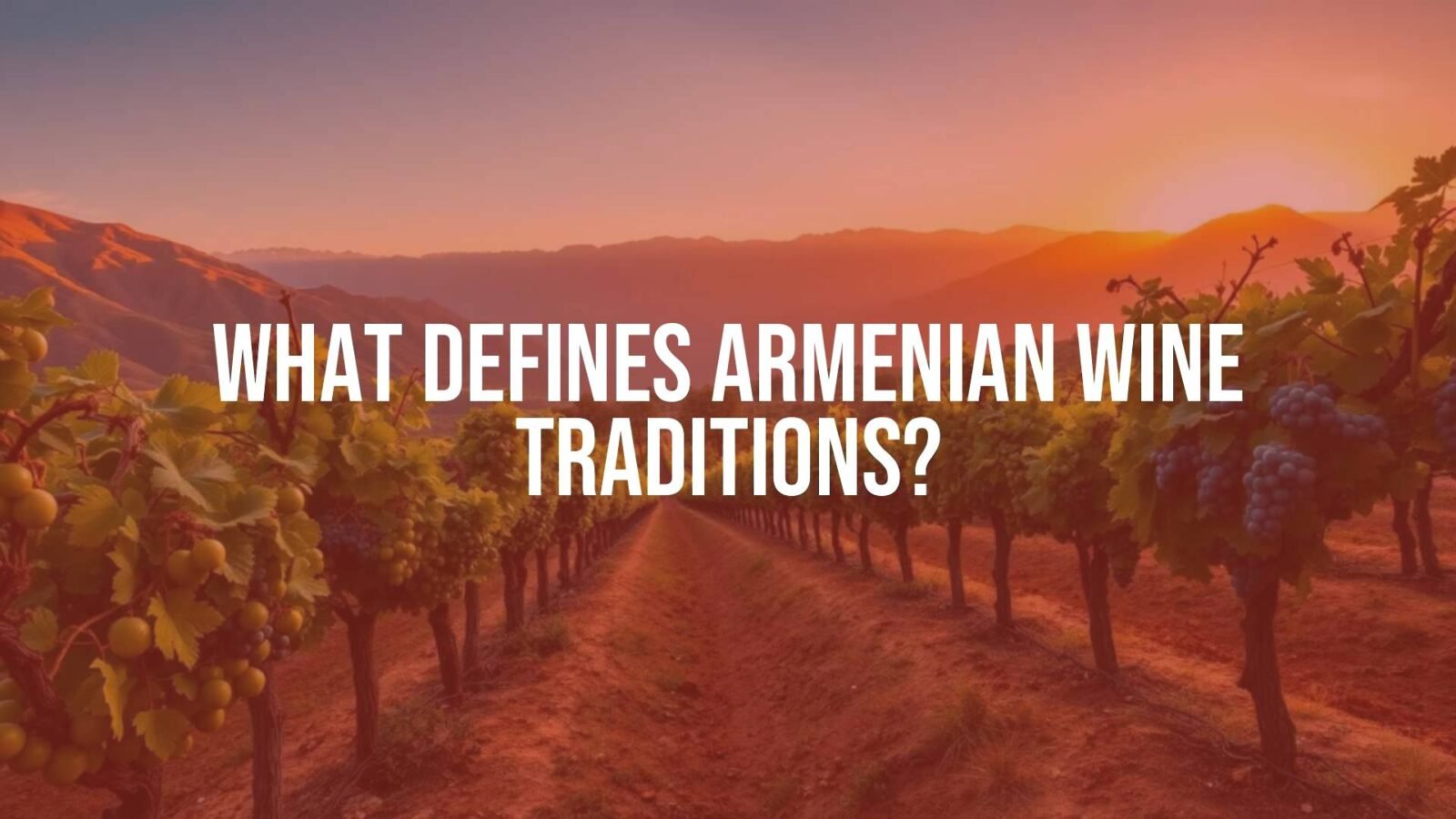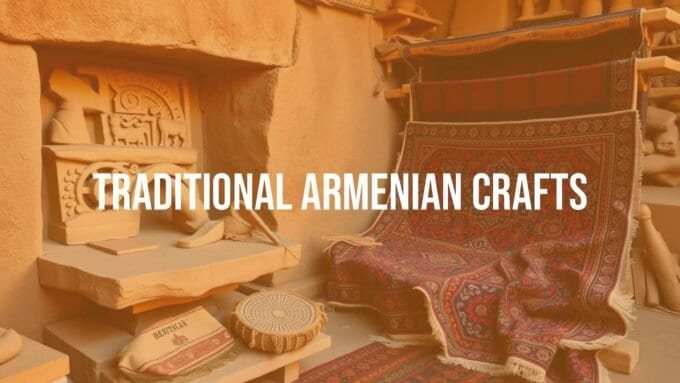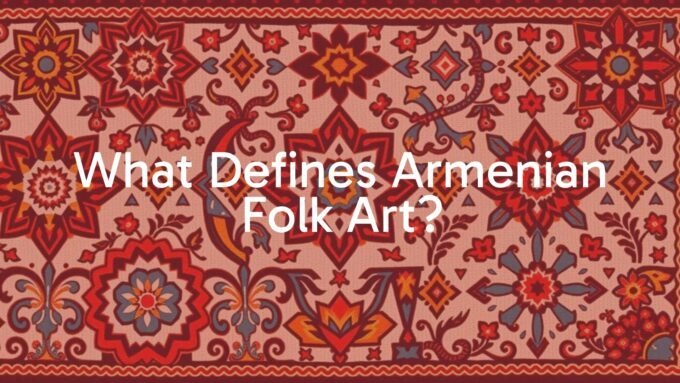Key Elements and Cultural Significance
Armenian wine traditions grow from thousands of years of history, special geography, and a strong bond with the vine. They mix old methods with a new wave of quality, built around native grapes, high mountain vineyards, and volcanic soils. Unlike many places that replaced their local grapes, Armenia still grows more than 400 native varieties, many found nowhere else. This wide range of grapes is a key part of the country’s wine identity.
Armenia’s rugged mountains, high average elevation of about 1,500 meters, many microclimates, and mineral-rich volcanic soils shape the taste of its wines. Warm days and cool nights let grapes ripen slowly, build layered flavors, and keep bright acidity. Because phylloxera never spread widely here, many vines grow on their own roots, giving a rare link to ancient vineyards.
Role in Armenian Society and Celebrations
Wine in Armenia is more than a drink. It carries meaning tied to identity, faith, and joy. In pre-Christian times it stood for life, fertility, and blessing, and was part of rituals. After Armenia adopted Christianity in 301 AD, wine became a symbol of the blood of Christ and a key part of church life. Monasteries helped keep grape growing and winemaking alive.
Wine also fills family and community moments-weddings, feasts, and gatherings-joining old customs with Christian faith. Sharing wine shows hospitality and friendship. The recent rise of the wine sector has added to this, bringing wine festivals and tourism that let people, both locals and visitors, taste this heritage up close.
History of Winemaking in Armenia
Ancient Roots and Archaeological Discoveries
Armenia is one of the oldest centers of winemaking on Earth. Evidence shows wine was made here at least 7,000 years ago. In 2007, the Areni-1 cave in Vayots Dzor revealed the world’s oldest known winery, dating to about 4100 BC.
Inside the cave, researchers found fermentation vats, a press, storage jars, and pottery with wine residue. Amphorae with grape seeds matched the DNA of the Areni Noir grape, still grown today. This find confirmed Armenia’s early skills and smart use of volcanic soils and climate. Even older jars across the country suggest wine was made here long before famous regions like Bordeaux or Tuscany began.

Influences from Historical Civilizations
Armenia sits at a crossroads, so many cultures passed through and likely shaped local wine habits over time. Written details on every influence are rare, but it is clear that Armenians kept core methods while learning from others. The long use of “karas” (large clay vessels buried in the ground) shows a strong local approach that adapted ideas rather than replacing them.
The biggest outside force in recent centuries came during the Soviet period. Central planners steered Georgia toward wine and pushed Armenia to focus on brandy and fortified styles like Sherry, Madeira, and Port. Table wine declined for about 70-75 years. Ironically, many native grapes survived because they were used for brandy.
Periods of Revival: From Soviet to Modern Times
Independence in 1991 opened the door to recovery. At first, the goal was to rebuild the broken sector. The real surge began about 15-20 years ago, helped by the Areni-1 discovery in 2007, which sparked pride and drew local, foreign, and diaspora investment.
Today’s revival blends history with modern skill. New vineyards are planted each year. Small wineries are rising, mixing karas use with up-to-date tools. The focus has moved to quality, the return of forgotten grapes, and global reach. The number of wineries has grown five times in under a decade, lifting wine tourism and Armenia’s profile abroad.
Major Wine Regions in Armenia
| Region | Altitude (approx.) | Key Grapes | Style Highlights |
|---|---|---|---|
| Vayots Dzor | 1,200-1,800 m | Areni Noir | Elegant reds, bright acidity, ungrafted vines |
| Ararat & Armavir | 900-1,100 m | Voskehat, Kangun, plus local and international | Riper, fuller wines; sunny, warm sites |
| Aragatsotn | 1,100-1,400 m | Milagh, Haghtanak, Areni, Kangun, Voskehat | Mineral notes from volcanic/limestone soils |
| Tavush | 600-1,000 m | Kangun, Lalvari, Banants | Cooler climate; fresh, aromatic wines |
| Syunik, Gegharkunik, Kotayk, Shirak | Varied | Mixed local grapes | Diverse styles, growing exploration |
| Artsakh | Lower altitudes | Khndoghni (Sireni) | Bold reds; heritage now preserved in Armenia |

Vayots Dzor: Home of Ancient Vineyards
Vayots Dzor is Armenia’s leading wine area. It holds the Areni-1 cave and vineyards that reach about 6,000 feet (around 1,800 meters). High elevation, sunny days, and a continental climate give great growing conditions.
Wines here are often elegant, balanced, and layered. Areni Noir thrives in these sites. The area is also free of phylloxera, so many vines grow on their own roots, a rare treasure. Each October, the Areni Wine Festival brings fans from many countries.
Ararat and Armavir Provinces
The Ararat Valley (Ararat and Armavir) is another key zone. It sits on a sunny plateau with some of the warmest weather in the country, which leads to ripe, bold wines.
Armavir, the largest wine region, runs from 900 to 1,100 meters, with Mount Ararat to the south and Mount Aragats to the north. The valley has long grown white grapes for brandy, but large estates such as Karas also plant both native and international grapes. Producers like Jraghatspanyan and Moonq continue long-held methods on clay and sandy soils, with a continental climate that supports healthy, high-quality fruit.
Aragatsotn and Tavush
Aragatsotn, in the northwest near Mount Aragats, hosts vineyards at 1,100-1,400 meters. Volcanic, limestone-rich soils and varied weather have supported vines for millennia. Wineries such as Van Ardi show the region’s aim to make clear, place-driven wines from Milagh, Haghtanak, Areni, Kangun, and Voskehat.
Tavush to the north is green and forested, cooler and more humid. Grapes like Kangun, Lalvari, and Banants do well here. Wines tend to be fresher, lively, and aromatic, different from the bolder styles further south. This range across the country gives Armenia a wide set of wine profiles.
Syunik, Gegharkunik, Kotayk, and Shirak
Beyond the headline areas, Syunik, Gegharkunik, Kotayk, and Shirak also add to Armenia’s wine picture. Syunik shares the mountain feel of Vayots Dzor but has its own voice, making deep reds with silky tannins and ripe red fruit like those seen in warmer Ararat sites. These regions help protect Armenia’s many native grapes and local styles.
Each province’s microclimate and soils bring out different traits in the grapes. As the wine sector grows, more vineyards in these places are being planted and studied, bringing new tastes and lifting Armenia’s name abroad. Every region adds a chapter to an ancient story.
Artsakh (Nagorno-Karabakh)
Artsakh (Nagorno-Karabakh) has a meaningful, but painful, place in Armenian wine. This area, once a breakaway republic with an Armenian population, sat at lower altitudes and was home to Khndoghni (Sireni). It also supplied oak for barrels. Its soils and climate gave bold reds with black fruit, deep color, and firm tannins that aged well.
War changed this. Fighting in 2020 and the takeover by Azerbaijan in September 2023 displaced about 150,000 Armenians and ended the republic. Many vineyards and wineries were lost. Growers are now planting Sireni and other grapes inside Armenia to keep this heritage alive as winemakers from Artsakh rebuild their work in new places.
Yerevan’s Urban Wineries
Yerevan, far from most vineyards, has become a lively center for wine. Wine bars, restaurants, and urban wineries help drive the revival. The city has grown into a gourmet hub, moving from a focus on spirits to a new love for wine. Menus now feature wide Armenian wine lists, and new bars open often.
These city spots play an important role in giving people easy access to many producers. They act as tasting rooms and places to learn. Some make wine in the city with grapes from nearby regions, showing a modern style that fits today’s life in Armenia. This energy supports demand and builds wider interest.
Native Grape Varieties and Unique Wines
Areni: The Iconic Armenian Red
Areni Noir is the red grape most people think of in Armenia. Grown mainly in Vayots Dzor, it gives deep ruby wines with bright fruit aromas and good aging potential. The vine is tough in the field but the wine is graceful in the glass.
Areni has a special DNA that does not match other grapes. It grows on its own roots and resists disease, fitting the high-altitude, volcanic, day-night swing of Vayots Dzor. Many compare it to Pinot Noir for its red fruit, fresh acidity, and silky tannins. It smells fruity, yet tastes structured and layered. Many small producers, from budget picks to top award winners, bottle pure Areni.

Voskehat and Other White Grapes
Voskehat is the leading white grape of Armenia. It makes medium to full-bodied wines with floral notes and hints of pear and melon, sometimes with a light savory edge. Armenia actually has more native white grapes than red, and Voskehat sits at the front.
Other local white grapes include Kangun, Lalvari, Banants (common in cool Tavush), Garan Dmak, and Dolband (used by Jraghatspanyan). These vines are well adapted to the country’s many microclimates and volcanic soils, giving a wide range of styles. The current revival is bringing more of these lesser-known whites back into bottles.
Khndoghni and Distinct Regional Varieties
Khndoghni, from Artsakh, is another key red. It can make serious wines with black fruit, deep color, and firm tannins. Many age well in barrel and bottle and suit rich meat dishes. The name Sireni is also used, especially as growers plant it more widely inside Armenia.
Beyond Areni, Voskehat, and Khndoghni, Armenia has many other local grapes. In Aragatsotn, Milagh and Haghtanak shape local styles. In cool Tavush, Kangun, Lalvari, and Banants make fresher, fragrant wines. New finds and returns are underway too, with names like Tozot, Chillar Gurmeet goat, and Garan Dmak appearing more often. With 400+ native varieties, Armenia offers a rare set of flavors and clear regional character.
Pomegranate and Fruit Wines
Armenia also makes fruit wines, with pomegranate wine gaining fans fast. Made from local fruit, it tastes quite different from grape wine and often ranges from sweet to semi-sweet.
Good pomegranate wines can surprise even those who prefer dry styles. Gevorkian Winery makes semi-sweet versions with bright acidity and a long pomegranate finish. Armenia Wine Company offers deep color, intense aroma, and a full-bodied yet lively taste. Voskevaz Winery bottles a clean, fruity style with high acidity that many suggest with grilled meats. Ijevan Wine & Brandy Factory is another classic pick with juicy, balanced fruit. People serve pomegranate wine at holidays like New Year’s, drink it cold over ice in summer, or pair it with desserts and cheeses.
Traditional Armenian Winemaking Techniques
Clay Karas (Amphora) Fermentation
A core part of Armenia’s old methods is the “karas,” a large clay amphora. This approach, seen in the 6,100-year-old Areni-1 site, ferments and often ages wine in these vessels, which are usually buried to keep temperatures steady. The process is slow and controlled, often with long skin contact that gives special texture and flavor.

This is similar to the Georgian qvevri method. Both are recognized by UNESCO as traditional practices where wine ferments with skins, seeds, and stems. The result can be richer texture, deeper color, and a clear mineral edge. Many homes in places like Ashtarak, Gyumri, and Goris still have “marans,” underground rooms for karas. More producers are bringing back karas use to make true-to-place wines that honor their ancestors.
Old-World Methods vs. Modern Innovations
Today’s Armenian wine mixes time-tested methods with new tools. Producers keep native grapes and techniques like karas, while also using modern equipment and science where it helps. Some wines lean into tradition; others use newer ideas.
Vineyard care and cellar work now include modern practices and advice from trained winemakers. Some age wine in Armenian oak and refine methods passed down for generations. The goal is not just to repeat the past but to raise the quality, bring back lost grapes and skills, and use cleaner, greener farming. This mix helps Armenian wines stand out, showing both history and fresh energy.
Family-Owned and Boutique Wineries in Armenia
Notable Family Estates and Their Legacy
Many of Armenia’s most exciting wines come from small, family-run estates. These families protect tradition, care for their land, and share their story with visitors and the wider market.
Old Bridge Winery in Vayots Dzor shows strong family drive. Started in 1998 by Musho’s father, it was revived by Musho and Lusine, who opened a tasting room in 2018. Momik Wines, run by Nver and Narine, welcomes guests with a warm setting and wines from Areni or Voskevaz grapes, named for the 14th-century architect Momik. Van Ardi, at the foot of Mount Aragats, was founded in 2008 by Varuzhan Mouradian, who moved from Los Angeles to build a legacy rooted in tradition and new ideas. His wife, Anahit, leads food experiences, and their daughters host guests. Voskevaz Winery, rebuilt from 2004 by David Hovhannisyan, makes a wide range from native grapes and ages some in Armenian oak, winning medals abroad each year. In the Ararat Valley, Jraghatspanyan Winery continues a family story dating to the 1890s with an underground cellar and long-tended vines.
Impact on Local Wine Culture
Family and boutique wineries have had a big effect on local wine. They brought old vines back to life, made wine popular again, and shifted tastes from spirits toward wine. These producers highlight native grapes and older methods.
They also support local jobs and village life, often in border areas where vineyards matter to the economy. Many now host tours, tastings, and food events. Places like Hin Areni, Van Ardi, and Voskevaz draw many visitors and build lively cultural stops. The personal touch of these families turns a bottle into a story of place and people. As sons and daughters step in, this culture keeps growing and changing.
Wine Festivals and Rituals in Armenian Culture
Annual Wine Festivals and Community Events
Armenia’s bond with wine comes alive at festivals that attract people from across the country and beyond. These events celebrate local wine and bring communities together.
Highlights include:
- Areni Wine Festival (October, Vayots Dzor): taste many wines, meet winemakers, enjoy local food and music.
- Yerevan Wine Days (May, Yerevan): city streets turn into open-air tasting halls with dozens of producers.
- Dilijan Wine Festival (Dilijan): a mix of forest scenery and wine culture.
These gatherings boost wine tourism and offer a warm welcome into Armenia’s traditions.
Wine in Religious and Social Ceremonies
Wine carries deep meaning in both sacred and social life. In pre-Christian times, it signified life and blessing in rituals. After Christianity, it became central to sacraments as the symbol of Christ’s blood.
From baptisms and weddings to memorials and family feasts, wine marks key moments and shared joy. Many old houses kept wine in underground “marans,” showing how wine links to family heritage. In Armenia, wine is part of daily culture as well as faith and memory.
Food Pairings and the Armenian Wine Table
Popular Dishes Served with Armenian Wines
Armenian food pairs naturally with local wines. Fresh produce, grilled meats, herbs, and cheeses match a wide range of styles. Try these classic matches:
- Areni Noir with khorovats (barbecue), lamb, or grilled beef.
- Khndoghni with hearty stews and strong cheeses.
- Voskehat with fish, salads, and soft or semi-hard cheeses.
The idea is simple: local food with local wine, shaped by long shared tradition.
Contemporary and Traditional Pairing Practices
While the old pairings still shine, chefs and sommeliers in Armenia are testing new matches. They explore how different native grapes can lift both classic Armenian dishes and modern plates.
Wine bars and fine-dining spots in Yerevan offer curated flights with food, showing how flexible Armenian wines can be. Fruit wines like pomegranate also earn a place with desserts, certain cheeses, or as an aperitif. Whether classic or new, the wine table remains a key part of Armenian culture.
How Armenian Wine Traditions Compare to Neighboring Countries
Distinctive Qualities vs. Georgian Wine Traditions
People often compare Armenia and Georgia, two ancient wine lands with deep respect for their vines. Georgia is famous for its 8,000 years of history and the “qvevri,” large clay vessels buried underground for fermenting and aging with skins, which can produce firm, tannic wines. Key grapes include Saperavi (red) and Rkatsiteli (white).
Armenia also uses clay vessels (karas) and has old roots, but several traits set it apart:
- High-altitude vineyards, many between 1,000 and 1,800 meters, add freshness and a distinct mineral feel.
- Large areas remain phylloxera-free, so many vines grow on their own roots.
- Native grapes such as Areni Noir, Voskehat, and Khndoghni have their own flavor profiles, different from Georgia’s well-known varieties.
Both countries share long traditions, yet Armenia’s heights, soils, ungrafted vines, and unique grapes give it a different voice in the global wine story.
Armenian Wine Traditions: Frequently Asked Questions
What Makes Armenian Wine Different?
Several things make Armenian wine stand out:
- Grapes: 400+ native varieties, including Areni Noir and Voskehat.
- Place: high elevations and volcanic soils add freshness and mineral notes.
- Vines: many vineyards are ungrafted and phylloxera-free.
- Methods: renewed use of clay karas connects modern wines to ancient practice.
These pieces come together to give wines with clear character and a strong sense of place.
Can You Take Wine Tours in Armenia?
Yes. Wine tourism is growing fast, with new routes and more open cellar doors.
Vayots Dzor is the most popular area, home to Areni Noir and the Areni-1 cave. Visitors can see historic spots, walk vineyards, and taste at many small wineries. Ararat, Armavir, Aragatsotn, and Tavush also offer varied scenery and styles. Family estates like Hin Areni, Van Ardi, and Voskevaz offer full visitor programs with tours, tastings, and food pairings. In Yerevan, wine bars and shops pour a wide range from across the country. Festivals such as the Areni Wine Festival and Yerevan Wine Days add great tasting days to the calendar.
Are There Award-Winning Armenian Wines?
Yes. Armenian wines now win medals at major shows around the world, a clear sign of rising quality after years focused on brandy.
Producers compete at events like Mundus Vini, the Paris Wine Cup, and Decanter, and bring home awards. Zorah’s amphora-aged wines helped put Armenia on the map. Hin Areni and Van Ardi also receive honors for focused, place-driven bottlings. The Armenian Vine and Wine Foundation promotes these wines abroad and helps secure a spot at international fairs and contests. Together, native grapes, volcanic soils, and high-elevation sites give Armenia a distinct edge on the global stage.
















Leave a comment